Adolph Mongo is a former journalist and Detroit based political consultant, who served as deputy director of Public Information under Mayor Young from 1984-1991. He is the host of the podcast, Detroit in Black and White.
By Adolph Mongo
Diane Washington recalled a time when she filled in as personal secretary for the late Mayor Coleman A. Young for a day. “That chair was very intimidating, she recalled. The mayor buzzed me on the intercom and said, ‘get that motherfucker from Sinai Hospital on the phone.’ I nervously looked through my Rolodex, scrolling down names and then told the mayor, ‘there are a lot of motherfuckers in here. Which one would you like to speak to?’ He came out of the office, laughing and said, ‘what’s your name?’ I nervously said, ‘Diane Washington, and I need this job.’ The mayor said that he was caught off guard and forgot what he was going to ask me. He went back into his office laughing. It was a real laugh. I never knew a person could curse like that.”
Young was many things to many people. To Georgia congressman John S. Woods, chairman of the House Un-American Activities Committee in 1952, he was a communist sympathizer. To white politicians such as the late L. Brooks Patterson, the Oakland County executive, Young was a race baiter and black militant, who ran the city into the ground. To Black people, he was a champion who stared down white bigots such as Patterson and Dearborn white supremacist mayor, Orville Hubbard.
Yet black radicals, like poet and activist, Amiri Baraka (Leroi Jones) accused him of being a tool of the white power structure and was out of touch with the young and upcoming leaders of the Black movement. And many community leaders in Detroit, said Young spent too much time building up downtown while ignoring the needs of neighborhoods. They argued neighborhoods needed help the most, an argument still being debated in 2023.
Complex Man, Brilliant Tactician
Nearly 26 years after his death, Coleman Alexander Young, the longest serving mayor of Detroit, is fondly remembered by many of those who served in his administration as a complex man, a brilliant tactician, a strong leader who could be charming, vindictive, funny, fearless and cunning. His cadre of political appointees, some who still reside in the Detroit area, say the late mayor changed the face of Detroit and helped lay the groundwork for its revival almost 50 years after his election in 1974. His imprint in city politics and business is still felt today. And despite the numerous articles written over the years about their late boss, many feel that those who worked for him can only truly tell his story. Marvin Beatty, former deputy fire commissioner from 1990-1994, eloquently summed up the feeling of his fellow appointees: “Coleman Young was the glue that held the community together.”
Ed Vaughn, a former Michigan State Representative, who later served as an executive to assistant to Young, said the late mayor was a compelling leader. “He believed in Black empowerment. He didn’t take a back seat to nobody. But he wasn’t the Black militant and progressive that many people thought he was. He fought with the Black Panthers and Black Nationalist that attended the Black political convention that took place in Gary, Indiana in March of 1972.”

Mayor Young and Anchor Bill Bonds (Photo by Ronald Flemming)
With over 10,000 attendees, it was the largest independent Black political gathering in U.S. history. Three thousand individual State Delegates composed of members of the Black Panther Party, The Nation of Islam, Black Republicans, Democrats and Black Nationalists were there in hopes of creating a Black agenda and political strategy to advance Black civil rights.
A who’s who of Black America, entertainers, politicians, activists and sport icons were in attendance at Gary’s Westside High School, which Included: Bobby Seale, Presidential candidate Shirley Chisholm, Muhammad Ali, Jesse Jackson, Louis Farrakhan, singer Harry Belafonte, Rep. Charlie Diggs, Rep. Barbara Jordon, Gary’s Mayor Richard Hatcher, Coretta Scott King, Betty Shabazz and Michigan State Sen. Coleman Young.
Vaughn said, “many of the far-left crowd booed Young when he stood up to speak. Tensions were running high. They claimed Coleman was part of the white establishment and that he was not speaking their language.” Adding, “Coleman thought that the Black agenda that was presented was unrealistic.” Later in an interview with a newspaper reporter, Young said the Gary platform was written by Leroi Jones. “They gave us this 10-page platform at 11 o’clock in the morning and asked us to endorse it by 3 o’clock in the afternoon. We asked for a chance to study the platform and go back home and hold a state convention. But they wouldn’t allow it.”
Tensions High
Vaughn said tensions ran high and tempers flared up. “We (Detroit delegates) had to stand up for him. Coleman was going to get his ass kicked at the convention.” Vaughn recalled. In his interview Young acknowledged, “We had a tough time getting out of there. I had been to Chicago enough that, I had my piece with me.” According to Young, in his book, “Hard Stuff,” he often carried a .38 caliber pistol under his coat. “We had to call in 200 of the toughest union guys to come escort us out,” Young stated. He added that “Congressman Charlie Diggs was slugged by Leroi Jones thugs because he objected in a minor way to some of the democratic process.”
He then led a walkout of the Michigan delegation. Young would later say, after sipping a drink in his riverfront apartment, “those motherfuckers thought that the federal government was going to give them eight to ten states.” Vaughn said Young’s toughness came from being from the south and growing up around racism and bigotry. “We were both from Alabama. We knew families who’s loved ones were lynched.” He added the city was no different than the south. “Detroit was hard on Black people, especially Black men. When I got a job at the post office, most of the Black workers at the Roosevelt station, which was then located in the old train depot were Black. They were doctors, lawyers, and dentists working there because they couldn’t practice their professions in Detroit.”
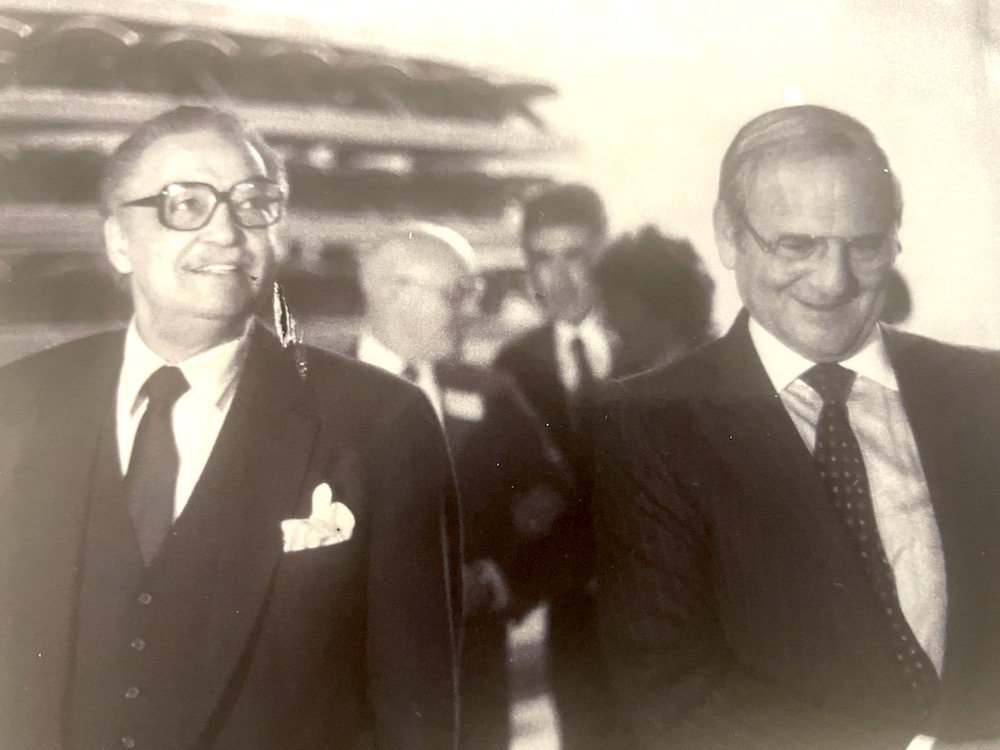
Mayor Young and Chrysler's Lee Iacocca (Photo by Ronald Flemming)
Vaughn said Jim Crow, poor housing, and the rise of the Klu Klux Klan in Detroit, also helped shape him and Young ‘s political thinking. The owner of the historically Black-owned bookstore in Detroit, said Young was smart and savvy. “He knew how to navigate the political landscape,” he said, and dismissed those critics who labeled the mayor as militant and radical.
'He Fired Me'
“Coleman was misunderstood. He was very comfortable with the white powerbrokers of Detroit and was willing to deal with those on the left,” Vaughn recalled. Coleman would meet with corporate heads once a month in his office with people such as the Max Fishers, Al Taubman and Henry Ford II. It was always closed-door discussions. I understood the purpose of those meetings. They were needed to create a strategy on how to move the city forward. And these powerful people also helped keep him in power. But he was never a wild-eyed radical as some made him out to be,” the 88-year-old Vaughn said.
Vaughn would later fallout of favor with the mayor over him running for city council. “Coleman didn’t want me to run. He fired me. But I was my own person. And I ran for council anyway,” Vaughn said. “We didn’t talk again until he left office.”
The Rev. Larry Simmons, Young’s chief political director, echoed Vaughn’s sentiment “He was not a Black nationalist. He was unmovable and demanding that black people had a place everywhere in Detroit society. His argument was that there should not be anything going on in Detroit that Black people didn’t have access to. Long before anybody was talking about set-asides, Coleman Young was advocating for it.”

Mayor Young, Nelson Mandela and Pistons (Photo by Ronald Flemming)
Sitting in his riverfront apartment after retiring from office, the late mayor stated, “The media threw dirt on me every chance they got. Called me every name in the book; a communist, a socialist and a racist. But I wasn’t any of them.”
StIna Santieste, who worked as a neighborhood city hall manager from 1977-1993, said she met the mayor as a 16-year-old campaign worker when he was running for state senate. What she remembered most about Young was that he was fearless, intelligent, and how he was able to get things done while coming under fire from the media and suburban critics. “He was embattled during most of his tenure as mayor,” she said, especially during the Ronald Reagan administration. Santieste said the mayor was able to get developments done despite all the hoopla that surrounded him. ‘His 50- 50 ratio of white and black appointees was extraordinary. It had never been done before, she said, a first for a big city.”
Hired More Women
“Mayor Young hired more woman in high profile jobs than any other administration in city history.”
Henry McClendon who worked for seven years, 1987-1994, in the Young administration, said the mayor, along with longtime union organizer, Davey Moore, fought with Ford Motor company officials to get Black women hired at their plants. “He wanted everybody included.”
Charlie Williams, who spent 17 years in the Young administration said in 1981, city residents voted to raise the local income tax to avoid letting the city go into bankruptcy. He said the late mayor laid out the strategy for the Vote Yes campaign: “First he had to get the legislature approval that would allow the City of Detroit to place a question ballot in front of Detroit voters.”
On June 5, 1981, former Detroit City Councilman and then-Lt. Governor James Brickley, broke a 19-19 tie in the state senate to allow the vote. “Me, Larry Simmons and Conrad Mallet Jr., worked to implement the city strategy. Williams said residents voted to tax themselves because they believed in the mayor. “The residents of Detroit fell in love with the mayor because they knew he would fight for them.” Gloria Killerbrew, while working in the neighborhood city hall, said she saw firsthand how people loved the mayor. “Whenever there were problems in the neighborhoods, the mayor made everybody get in the streets to get them resolved.”
Daniel Aldridge, who spent over a decade in the administration, says the late mayor completely changed the culture of Detroit “particularly in regard to the police, fire and health departments. That was his legacy. Coleman was a real mastery of finance.”
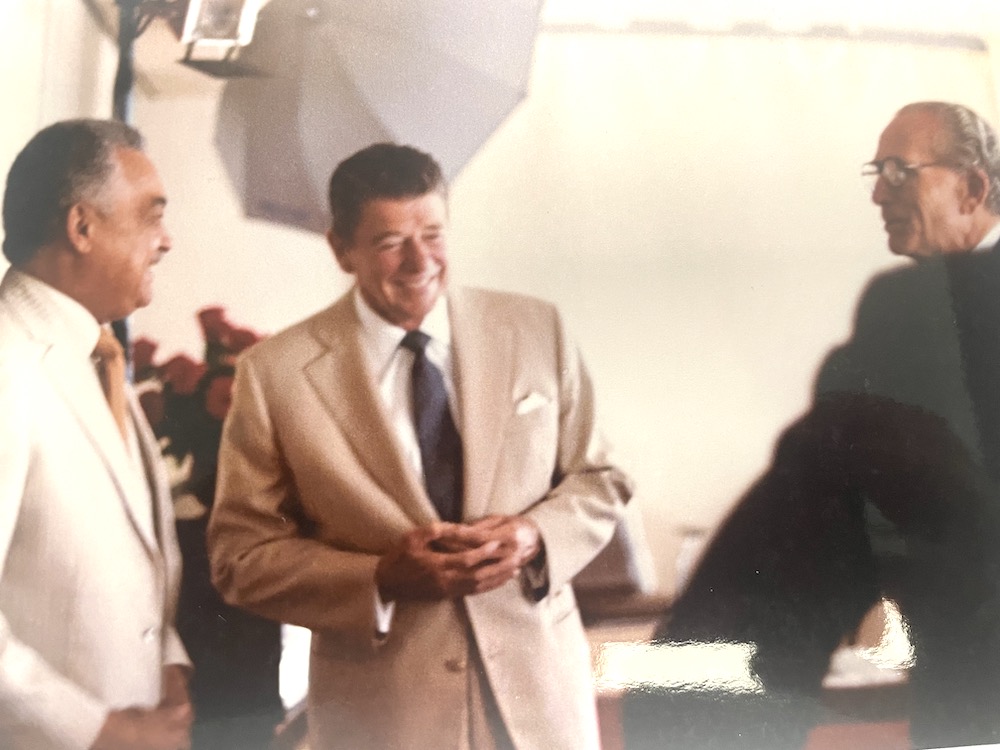
Mayor Young yuks it up with President Reagan (Photo by Ronald Flemming)
"The white population had abandoned Detroit. He didn’t have the resources like other previous mayors. Coleman had to deal with financial issues and tackle violent crime in the city at the same time. He got it done with the limited resources available.”
Aldridge said Young didn’t trust the predominantly white police department when he assumed office. Young campaigned on police reform. His first official act as Mayor was to shake up the status quo of the Detroit Police Department. He eliminated the controversial undercover decoy unit known as S.T.R.E.S.S., a unit that killed 22 young Black men in the early 1970s. Young later stated that disbanding “this death squad” was probably one of his top accomplishments in his 20-year reign as mayor.
Avoiding a Shooting
“One day, I got a call from the mayor,” Aldridge recalled. “He said, Dan, you know the eastside, there is a woman holed up in a house near Mack Ave with a rifle and threatening to shoot the police. I don’t want a black woman killed by police on my watch. Go there and try getting her out of the house because it is surrounded by a team of all white cops. Get the woman out of there. I was able to talk to the woman for two hours and convinced her to surrender and to leave peacefully. She gave me the gun and said, ‘you sure are a very nice young man.’ The mayor was relieved because he didn’t want a woman especially a Black woman, killed by police.”
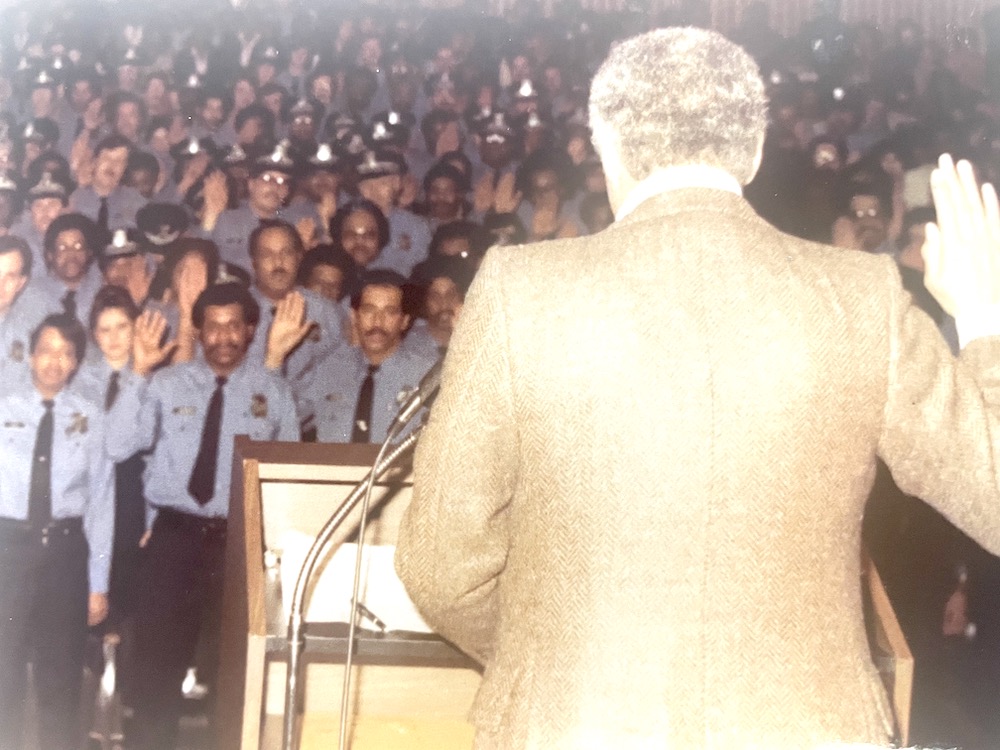
Mayor Young swears in new officers (Photo by Ronald Flemming)
When Young dedicated a new police mini station in the Harriet Tubman Terrace housing development in June of 1974, he told residents, If the police don’t cooperate with you, then I want to hear about it, and if you don’t cooperate with the police, I’m going to hear about that too, and you will see me here again.”
Emmett Moten Jr., who was community and economic development director for 15 years, said the late mayor was a serious negotiator and tactician. Moten said Young made things happen. “Many people think the Veterans Administration hospital in the Detroit Medical Center, was the result of efforts of the late congressman John Dingell. Since 1954, officials in Michigan had been trying to get a new VA hospital built, but to no avail,” Moten said. “The hospital in Allen Park at the time, was old and deteriorating. The late businessman Frank Stella, and former WSU president David Adamany, helped the mayor put a plan and strategy together that convinced the VA to purchase land in the medical center. And they built a new hospital. The old hospital was in Dingell’s congressional district, and the mayor knew Dingell would oppose a new one that was not being built in his district. John would have killed it. By the time he found out about it…it was too late for him stop it. They just put his name on the building. Young wanted it done. And he made it happen.”
Helene Flowers, who spent 17 years as a member of the support staff, said the mayor was all business. “But he always had time to take the support staff to events like the Tigers baseball games and that’s how we got to see another side to him and that is also how he got to know us.” She said he was a tough taskmaster in the office.
Took Her Resume
Beverly J. Watts, an appointee who worked from 1989-1994 in his administration added, “He was a benevolent person who took a chance on a young recent graduate of MSU. I wanted to work for him, after watching him give an interview on a television station that I was working for as an intern,” Watts said. “I drove to the city county building during a snowstorm. I was naive to think the mayor worked from 9 to 5. I waited five hours for the mayor to come down to his car. He was surrounded by five people including his security. The guard at the door told me go ahead and give him my resume. But before I could give it to him. I was blocked by his security. ‘Let her come here,’ the mayor said. He took my resume, but he was more concerned about my safety because of the weather. As he left, he looked at me and said, ‘I can’t guarantee anything,’ but a few months later, I was offered a job as a provisional appointee.”
Ninety-three year-old, George Gaines, served as the deputy city health director at Herman Kiefer Hospital for 17 years. Gaines said the city faced two epidemics, TB and HIV during Young’s tenure as mayor. “He allowed me to do the things I needed to do. The health department was directed to pass out clean needles and give bleach to heroin addicts and showed them how to clean needles. “Some council members criticized the mayor,” Gaines added, “saying he was encouraging drug use. We were trying to stop an epidemic.”
Gaines believes that Young was ahead of his time in battling those diseases. “He let us use our technical skills and was always on board with the department. “
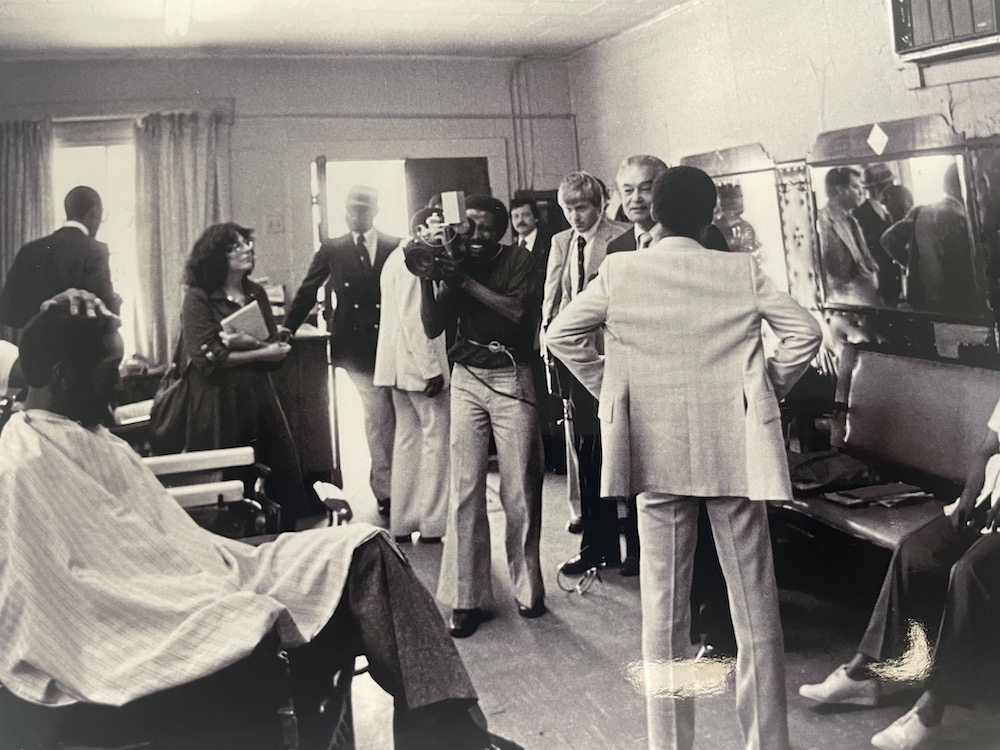
Mayor Young at his father's father's barber shop in Tuscaloosa, Alobama (Photo by Ronald Flemming)
Gaines also remembered Young as very loyal to those who were close to him. “I tried to tell his companion, Barbara Parker, who also served as an aide in charge of programs for the homeless, hungry and aging, that the warehouse where they were storing cheese and butter, to give to needy Detroit families, was unsanitary and wasn’t fit to store food.”
Gaines said one of his assistants, Ron Hewitt, “called me and said, ‘stay out of our business.’ I tried to tell the mayor. But he didn’t listen.” Over 150 tons of surplus government food intended for the hungry, worth $410,000, spoiled in March of 1984, from the unsanitary conditions inside the building that Gaines said, was not suited for food storage. Young took full responsibility for the food spoilage, but said it was “minuscule” compared to the 7,000 tons distributed by the city to feed the hungry population. “That (spoilage) was criminal, that shouldn’t have happened.” Young never blamed Parker for how she handled the improper food storage.

Mayor Young (center) with President Carter (Photo by Ronald Flemming)
Iris Ojeda and Dona Wash said being part of the support team which allowed them to work closely with the mayor, had its ups and down. “Sometimes the work outside the office consisted of long hours and sometimes grueling work,” said Ojeda. Many powerful political candidates and elected officials, plus people with influence, found their way to the 11th floor of the city county building to seek his support, said Flowers. “I remember when then-Georgia’s governor, Jimmy Carter came to the office, to ask for Mayor Young’s support, because he was running for president.” Wash, said “some of the toughest times came when we had to campaign after working all day.” Ojeda said going door to door, passing out doors knockers, working political campaigns and doing devil nights’ patrols was tough at times.
Young's Confidantes
Diane Washington spoke of some interesting experiences during those times. “One man thought I was former Congresswoman Barbara Rose Collins and another time, Rosa Parks answered the door, duing the census recount campaign. Bill Clinton, she said “was smooth and sexy,” Nelson Mandela, was tall and had a spiritual aura about him, and Minister Louis Farrakhan was an interesting person, but his bodyguards were intimidating and scary. Ojeda remembers UAW President Douglas Fraser’s visits with the mayor and that Aretha Franklin was also a Young confidante.
Beatty, currently the board president of the Coleman A. Young Foundation, maintains the former mayor was the absolute savior of the police and fire departments. “Under Coleman’s leadership, promotion standards were changed.” He said those departments were bastions of nepotism. “Under his leadership the mayor created a different kind of energy. He changed all those things that were so detrimental to Black folks.”
“When I joined the department in 1972,” Beatty recalled, ‘there were only 81 Black firefighters. I was number 82. We had no Black chiefs, there were no Black officers because the fire department was a friends and family opportunity. Beatty said Black applicants were rejected for things such as a bad driving record, not being tall enough, and not having enough teeth. The first two African Americans hired in Detroit in 1947 were college educated. That was the only way we could get hired.”
“He made major changes in the fire department. Mayor Young established the EMS. Prior to all that, all medical responses were done by the fire department. He appointed Melvin Jefferson as the first Black fire commissioner and brought women on board. The fire department under previous administrations mistreated black people.”
Beatty said white firemen had no problem breaking windows and tearing down doors of Black residents houses during fire calls, but were very careful with homes of white residents.
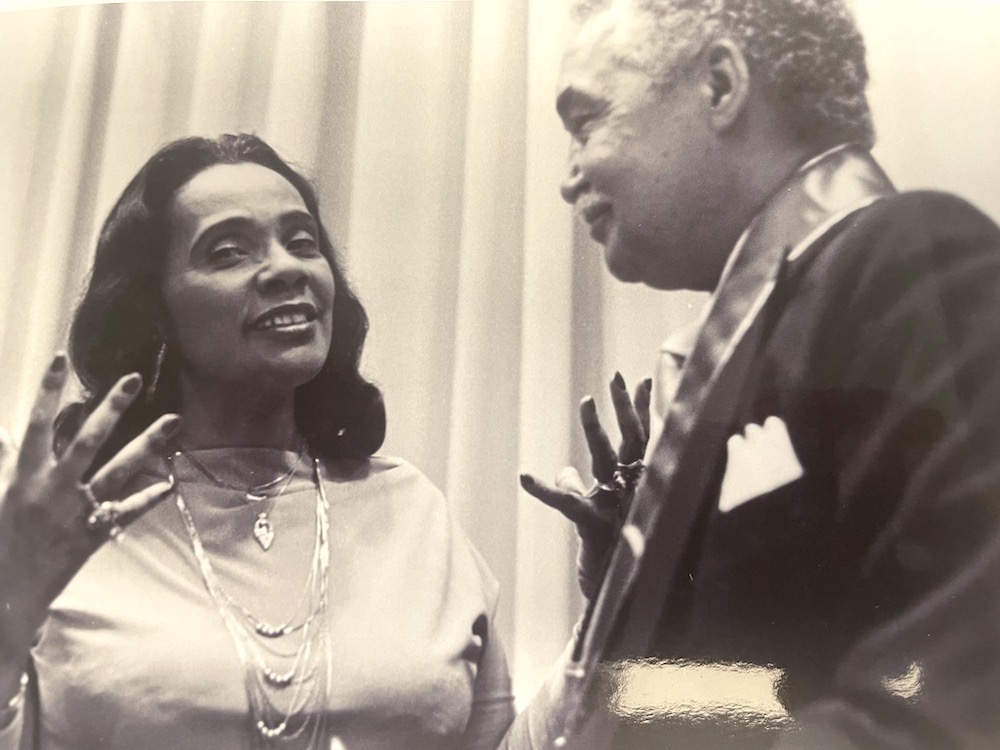
Mayor Young and Coretta Scott King (Photo by Ronald Flemming)
He said one of Young’s greatest legacy is the Coleman A. Young foundation. Since its inception, the foundation has awarded 400-plus scholarships. “He thought the community would revitalize itself through educating young people and providing them with the leadership through the endowed chair at Wayne State University,” adding that “94 percent of it recipients, graduated from four year institutions.” According to an August 17, 1993 Detroit Free Press article, Young donated $2.4 million dollars to the CAY foundation and one million dollars to fund a teaching position in his name at Wayne State University. “His donation was a billion-dollar investment. Wayne State would engage African American students, to create avenues and education pathways for them,” Beatty said. “He believed in young people. “
The TV Judge
Judge Greg Mathis, before gaining fame as a celebrity TV judge, served as a manager of a neighborhood city hall from 1989-1992. He said when gangs were terrorizing the city, Mayor Young was one of the few big city mayors to call an anti-gang summit to see how the city could get gang members involved in the community. He established a job training program. “He wanted to build up our youth and not lock them up,” Mathis remembers. As a 17-year-old, “I was incarcerated for nine months. But the judge, gave me a second chance. He ordered me to get a GED and a job. I got my got my Ged from Operation Get Down, one of the mayor’s anti-gang programs. After I had my record expunged, and obtained a law degree, I started running campaigns.”

Mayor Young and Hubert Humphrey (Photo by Ronald Flemming)
“Twelve years after the gang summit, Charlie Williams and Larry Simmons introduced me to the mayor. Before we talked, I wanted to let him know about my criminal background. ‘Mr. Mayor, I want you to know that I was a member of the Errol Flynn’s gang.’ He roared, ‘you were one of those mfs.’ He chuckled and said ‘come here you little mf,’ while giving me a hug.”
Mathis said, Young was directly responsible for getting him elected to the 36th District Court. “I was the youngest judge in Michigan at that time, and it created controversy. People said, I practiced politics and not law. They were shocked and upset that I ran against an incumbent judge. The judge was a throwback to the times before the mayor took office. He practiced locking up young people instead of lifting them up. He didn’t believe in giving out second chances.
“My victory was the direct results of Coleman Young putting me in a position to get to know the grassroots community. I was able to mobilize them,” Mathis said.
Beatty concluded, “We lost a great leader in Coleman Young and unfortunately we haven’t had one since. He didn’t position a transfer of power.”











